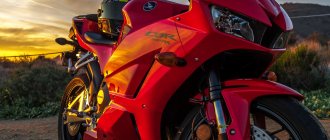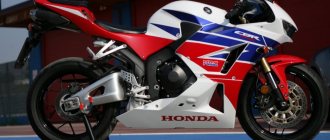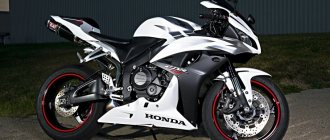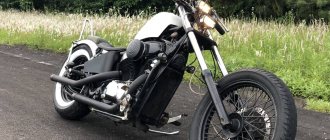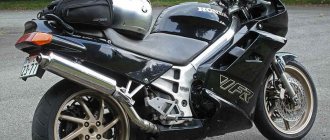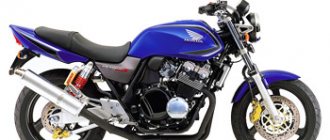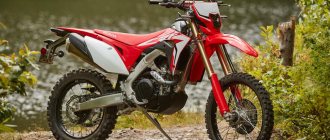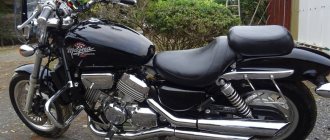The Honda CBR600RR motorcycle is a return to the roots. When releasing the previous line of sports 600s, Honda deviated slightly towards comfort, and, obviously, decided to correct itself. The new 600RR is a truly radical sportbike without flirting with the sport-tourer class, angry, powerful and uncompromising. Its technical characteristics allow it to easily dominate on any road, provided it has good asphalt and an experienced pilot.
Design
The sly squint of the double headlight - Honda racing motorcycles. The designers of the Japanese company do not hesitate to exploit this recognizable image, and this is only for the better! How many motorcyclists have fallen madly in love with the 600PP at first sight precisely because of its appearance? How many Chinese companies produce their “copies” that imitate the design of this bike? But he doesn’t care, because a fake will never become an original, and such popularity is just another evidence of popularity.
Specifications
Beginners should give this motorcycle a tenth of a ride until they gain enough experience to handle it. The Honda CBR600RR has characteristics that fully correspond to the title of a sportbike . This model was developed on the basis of a purely racing RC211V, which was simply adapted for public roads. Hence the explosive nature and all other features characteristic of specialized equipment designed for the track, and not for city streets.
Engine
Despite all the improvements and changes, from an operational point of view, the Honda CBR 600RR engine has remained virtually unchanged over the years. It's the same 4-cylinder, 4-valve, liquid-cooled engine , which comes to life and begins to show its character at about 7,000 rpm . After this mark, it has no dips or pick-ups; the torque curve on the graph clearly demonstrates this. Power ranges from 117 to 120 hp. , torque reaches 66 Nm , and top speed is 256 km/h . The bike accelerates to 100 km/h in 3.16 seconds.
Transmission
Traditionally, Honda has a perfectly functioning gearbox that never has any problems. Already on the third, the bike is capable of accelerating to 150+ km/h, although, of course, you should not abuse the power. You can switch to the top gear, sixth, when the number “100” appears on the speedometer, and then drive like an automatic transmission. Although for sharp overtaking you can drop a few gears.
Chassis and brakes
The lightweight and durable aluminum frame has already been changed three times, but the overall geometry of the sportbike has remained almost unchanged. The brakes, as with all CBR motorcycles in the line, deserve exceptional praise; there are 4-piston calipers with 310 mm discs at the front, and a single 1-piston caliper with a 220 mm disc at the rear. Since 2009, a combined braking system with ABS .
Electronics
Auxiliary systems and other electronic stuffing went mainly to the “liter”, but the “six hundred” in this regard is almost no different from the CBR F4i. This is for the best - the predecessor of this model was famous for its reliability, so complicating the design could have a negative impact on it. But it is worth considering that the electrical wiring is not reliably protected from water entering under pressure. The motorcycle is not afraid of rain and puddles, but you need to wash it with some kind of Karcher with care so as not to spill anything on it.
Weight and dimensions
Compact dimensions (wheelbase length - from 1370 to 1395 mm) combined with a dry weight from 186 to 199 kg, depending on the year of manufacture, make the Honda CBR600RR a fairly light motorcycle. The seat height is also low, only 820 mm, so most motorcyclists can confidently touch the ground with their feet. And the width at the extreme points does not even reach 700 mm, thanks to which the sportbike freely filters between cars in traffic jams.
Controllability
The combination of modest weight, short wheelbase and low fork angle make this model excellent handling. She is not afraid of sharp maneuvers or taking long turns at high speed, and never loses touch with the road, if, of course, you fork out for good tires. But you need to hold the clip-ons confidently, since hitting a road bump in some cases can lead to wobbling.
Fuel consumption
According to Honda, on average the SBR600RR consumes about 5.5 liters per 100 km . This seems to be true, and in the combined cycle the consumption remains moderate. But if you “ drive with all your money ,” it will increase, and can reach 10 liters per 100 km at maximum speeds. However, how often do you see straight roads 100 km long on which you can maintain a speed of 250 km/h for a long time?
Price
Should you keep your racing dream within the realm of fantasy or make it come true? The answer often depends on price. Depending on the moment of release, the condition of the bike and the seller, the price may vary. For example, a new six hundredth supersport from an official dealer costs about 900 thousand rubles. The regular version with combined ABS costs about the same.
On the secondary market, prices start from 200 thousand rubles; in good condition, you can buy equipment produced in 2003 with documents for 300 thousand rubles.
When choosing a used sportbike, you want the mileage not to be covered on Russian roads, and that all components are suitable for safe riding. For reality to coincide with expectations, it is worth discovering the Japanese motor market. You can see prices at a Japanese motorcycle auction for this model here.
It is enough to study a few lots to make sure that your dream can materialize.
Motorcycle price
The cost of used first-generation copies starts at 220-230 thousand rubles , but most of the cheapest options turn out to have a whole bunch of problems, from a knocking engine to dubious documents. A bike in “live” condition will cost 250-280 thousand rubles , at least. And the fresher it is, the more expensive it is - a Honda CBR600RR motorcycle from 2017-2018 can easily cost 750-800 thousand rubles . A completely new copy in a dealer showroom costs about a million .
Flaws
After the developers’ statement that they studied all the problems of the class on competitors’ models, you don’t expect any problems from the bike. But Honda distinguished itself with this model.
Each user notes the high cost of branded consumables: “ It’s not a problem to get them, but they are expensive .”
Advantages
There are many more advantages:
- power;
- convenience for the city;
- possibility of registration with the traffic police;
- large trunk;
- heated handles (out of the box);
- strong brakes.
Repair and tuning
Modern motorcycle technology is a delicate thing, and you shouldn’t get into it with your own hands, unless, of course, you are sure of what you are doing. Otherwise, it is better to entrust the matter to professional motorcycle mechanics, since unqualified intervention in the operation of the motor and auxiliary systems can lead to problems.
Repair
From a technical point of view, you can repair the Honda CBR600RR yourself, but this depends on the specific breakdown. It is better to replace some components entirely, or take the bike to a trusted motorcycle service center. A miser pays twice, and at a speed of 200 km/h, the cost of a mistake can be your life.
Spare parts
From official dealers you can buy (or, in extreme cases, order) anything, from plastic to a new engine. The prices are quite high, so third-party manufacturers will come to the rescue. In China, the production of complete sets of plastic of various qualities has long been established, and many consumables and parts are produced in the USA and Europe.
Tuning
Most often, owners change lighting equipment by installing more efficient headlights. Long-distance riders and tall pilots sometimes consider taller windshields, while racetrack enthusiasts often shell out for increased traction. But a sportbike is not a cruiser, and there is much less external tuning such as a body kit in this class, and what is available costs moderate money.
"Asymmetrical response." Review of the motorcycle Honda CBR600RR, 2007
Honda held a presentation of the updated version of the top-end sportbike CBR600 ahead of all showroom premieres. In order to dominate the most important segment of the 600 market, we have to stay ahead of the curve.Usually, on the eve of the autumn European motorcycle exhibitions, there is a shortage of objective information in the press and on specialized websites. The companies, as if by agreement, flatly refuse to comment on journalists’ assumptions about the debut of this or that model. Leaks, if they occur, are only planned, and, as a rule, they are designed to put the public on the wrong trail. This is understandable. The more unexpected the presentation at the salon, the greater the chance of hooking the consumer. No sensations were expected from Honda this year.
Last fall, the company thoroughly shot back, and, considering that the period before the next restyling is now two to three years, the 2007 model year for Honda did not promise any shocks. Well, the colors will be changed, the exhaust systems will be remade for Euro 3, a couple of new nuts will be screwed on. And suddenly journalists receive an official press release for the 2007 CBR600RR. Shock! It's Japanese! But the casket just opens. A year ago, Honda's main competitor, Yamaha, released the new generation YZF-R6, which immediately pushed the current CBR600 into the far corner.
It is clear that Honda could not come to terms with this (after all, it is called the No. 1 motorcycle concern in the world) and forced events - it gave the green light for the production of a radically redesigned sports “600”. There was little time - you couldn’t do everything. That is why there are no radical changes in design. Only the bottom of the fairing is reminiscent of the formidable features of its older brother - the liter Fireblade sportsbike, and the predatory air intake between the headlights indicates that the rookie does not intend to lose seconds in high-speed races with competitors. The inertial supercharging system is not an empty phrase here. The designers managed to endow this “six hundred” with the character of a “liter”. The CBR600RR won't run out of steam at high speeds, and 280km/h is now within reach. It should be noted that in such extreme conditions the engine does not give up, but seems to turn on a second wind. The competitor YZF-R6 flaunts 130 forces, but the new Honda has only 120. Is this the short-sightedness of the developers or a deliberate play for the downside? The latter is more likely. The press release repeatedly repeats the phrase “we wanted to make the motorcycle more rider-friendly.”
So, we can assume that the arms race (read: the race for power indicators) is coming to naught. Manufacturers have finally remembered the pressing operational problems and are no longer striving to inflate the characteristics to prohibitive values. But you are welcome to use 100 percent of what you already have. It is on this principle that the new CBR600RR is tailored. Consumer qualities are at the forefront. The power unit has been redesigned to make its characteristics smoother and improve operational capabilities.
Since 600 motors, as a rule, operate at extreme conditions, the designers paid great attention to resistance to overheating. The cooling system has been radically redesigned, and the piston heads are cooled by oil nozzles. The intake and exhaust systems have been optimized, many of the parts of these units are completely new. Thus, the CBR is equipped with single valve springs at the exhaust (double valve springs remain at the intake), a lightweight and smaller clutch, a lightweight generator, completely new pistons (the design of the connecting rods is also completely different), a magnesium cylinder head cover, and a modified gearbox with a shortened crankcase. The exhaust system, although outwardly reminiscent of the previous one, is, according to the designers, made from scratch.
One of the innovations here is a built-in valve in the style of EXUP from Yamaha. As a result, the engine characteristics became more even, without dips at the bottom and without sudden surges at the top. By the way, these same tops were increased only thanks to the inertial supercharging system. The injection system has been redesigned with two injectors per cylinder and an additional damper in the airbox. So the connection between the throttle handle and the dampers is ideal. The fairing makes it difficult to understand how much the frame design has changed. The press release claims that it was made using new casting technology, which made it possible to lose more than one kilogram of weight.
In total, fitness classes led to the loss of almost ten kilograms! However, Honda’s “trick” regarding the friendliness of the new CBR600RR does not, of course, refer to the improvements listed above. First of all, the newcomer is distinguished by ergonomics that are completely unconventional for 600 cc sportbikes. The handlebars are raised by 10 mm, the footpegs are slightly shifted forward. What does this mean? There is no more fetal position with heavy use of the hands. The landing has become almost classic, which means better control over the road and ease of landing. On such a sportbike you can fly to the south and back in one fell swoop! The standard electronic steering damper also hints at the fact that the car will now be easier to drive than its predecessor.
Yes, yes, the same HESD that has been adorning the CBR1000RR Fireblade for a couple of years now. Of course, it had to be modified a little so that it would not interfere with steering so much. The designers claim that its work is “transparent”. Well, let's take his word for it. The wheelbase was reduced by 15 mm - this is evidence that the developers not only talked about better handling, but also achieved it. What did we get in the end? An elegant, fast and technically sophisticated sportbike. Yes, in terms of basic parameters it is inferior to its main competitor, the R6, and, at first glance, Honda was a little hasty with its debut. But do numbers alone decide the fate of a car? For many consumers, the difference of a couple of “horses” and kilograms is insignificant, but handling and a sense of control over the car, on the contrary, are paramount. So there's no reason to say that Honda is in trouble with the CBR. Such motorcycles are not made off the shelf.
Specifications.
Motorcycle modifications
Over the years of production, the sportbike has undergone a number of changes. Here are the main ones:
- Honda CBR600RR 2003 . Start of production and sales. The following year there were no noticeable changes, only various little things like changed numbers of some spare parts. Structurally, the Honda CBR600RR 2004 and 2003 model years do not differ in any way, as can be clearly seen from the photo.
- Honda CBR600RR 2005 . Release of the second generation. The motorcycle received an updated frame, swingarm, as well as improved suspension and brakes, while losing 10 kg of weight.
- Honda CBR600RR 2007 . The third generation, which came with a new engine. Power, however, increased by only 1 hp, but the bike received an electronic steering damper, and overall began to handle noticeably better thanks to the reduced wheelbase.
- Honda CBR600RR 2008 . The production of the third generation continued, but the available color range was significantly expanded.
- Honda CBR600RR 2009 . The engine was slightly improved, adding a couple of “horses”, and the installation of an ABS system, working in conjunction with combined brakes, began.
- 2013 - Production of the fourth generation began, and the design was noticeably redesigned. The suspension has been heavily modified. Since then, there have been no noticeable changes until 2022, so we can expect the fifth generation to be released soon.
Advantages and disadvantages
Honda has been producing sports motorcycles for half a century, and has vast experience in this area. Knowing full well that the perfect balance in everything is unattainable at once, they focused on making the SBR600RR as close as possible to professional racing motorcycles. And they succeeded.
Advantages
- Crazy dynamics , just over 3 seconds to 100 km/h! The maximum speed exceeds 250 km/h.
- Modest fuel consumption . On the track it rises sharply, but during quiet driving it hovers around the 6l/100 km mark.
- Spacious 18-liter gas tank . When driving on the highway at a speed of 130-150 km/h, the range reaches almost 300 km/h.
- Excellent wind protection . If you lie on the tank, the headwind will not bother you even at speeds over 200 km/h.
- Excellent suspension with adjustments . This is doubly true for generations 3 and 4.
Flaws
- Uncomfortable seating position for tall riders. The ergonomics are well thought out, but the Honda CBR 600 is simply small in size.
- Weak standard light . On unlit roads it is objectively not enough.
- Lack of ABS on early copies.
- The sensitivity of the engine to oil starvation, which can very quickly damage it.
- Problem with the timing tensioner on the first two generations. The problem is eliminated once and for all by replacing it with an analogue from the fourth generation.
Brief review of the Honda CBR 600 RR model
Several years of hard work on the motorcycle and further victories - and Honda becomes the main manufacturer of engines for Moto2 racing motorcycles. It is not difficult to guess what kind of engines Honda supplies to the championship - engines from 600RR, updated and adapted, which have proven their reliability and excellent potential. The CBR 600RR has been refined for 10 years to keep winning.
Separate seating for the passenger and driver is a hallmark of a sports motorcycle , which confirms both the letter designation “RR” in the name and the established opinion that the 600RR is intended only for the track. A pronounced sporty stance, a high-spirited engine and a sporty body kit – everything is right.
However, the 600RR also performs well as a “sport tourer”: long trips are quite easy for it, thanks to its comfortable seating position and low fuel consumption.
But these motorcycles also have one specific “disease”: with increasing mileage, the chain begins to knock at 3-5 thousand rpm . The reason lies in the “worm” of the chain tensioner and the chain itself. A convenient feature is present in the injection system - the ability to self-diagnosis: when the ignition is turned on, the lamps on the display indicate a malfunction.
Simple and easy to drive, the CBR 600RR performs well in any conditions, be it the race track or narrow city streets.
We invite you to evaluate the technical characteristics of the Honda CB 400, a close relative of the hero of our article.
For fans of 4-wheelers, we have a review article about ATVs from.
Owner reviews
The motorcycle is very vicious, I categorically do not advise beginners or simply inexperienced riders to ride it! It takes off from a standstill like a rocket, and gets on the rear wheel in second or third easily. The brakes help out, especially with combination brakes and ABS, but they are absent on the first generations. I switched from a 400cc Seabihi, the first season I drove like a pensioner, it was just scary. It’s for the best, probably, the Honda SBR 600 RR is a technique for the experienced, or for the completely frostbitten. Arthur, Rostov-on-Don.
I really like the engine, of course there is no low end, but after picking up at 7000 rpm, the acceleration is smooth, without failures, not like on Erks from Yamaha. It steers great, the brakes are 5+. The downside is that the standard light sucks, you have to install xenon, but they can deprive you of your license for it. Well, if you are tall (190+ cm), sitting for a long time is not very comfortable; you have to shrink and lie down on the tank so as not to blow away; your arms and back quickly become numb. And you need to be more careful at the car wash; water under pressure can get into the cracks under the seat and between the plastic and flood the contacts, then you’ll have to take everything apart and dry it. All of the above is relevant for the Honda CBR 600 RR 2004; it may be different on more recent models, there have been many changes. Alexander, Moscow
My experience is negative, but what is it? I took a 2006 CBR600 with 18k mileage on the odometer, I drove about 2k when the engine started knocking. I had heard a lot about the birth problem with the timing belt tensioner, but that wasn’t the issue; when the engine was disassembled, it turned out that the CPG was already running out. Apparently, the previous owner did not leave the track, or drove constantly, but the engine was already on its last legs, so I had to cheat it and sell it urgently. Evgeniy, Tyumen.
Similar models
- Yamaha YZF-R6 . A world-famous racing bike that enjoys a unique reputation due to the explosive nature and “twitchy” nature of the engine.
- Kawasaki ZX-6R . It has been produced for a long time, so only those generations that were produced simultaneously with it can compete with the hero of our review.
- Suzuki GSX-R600. Direct competitor to all of the above models.
FAQ
- Is there a noticeable difference compared to the F4i? This is subjective, but in general yes. The F4i has a noticeably more flexible character.
- Is this bike worth getting, or is it better to save up for a liter CBR? If we talk about power, then even the “six hundred” has enough power. But the “liter”, oddly enough, is more smooth, especially at low speeds.
- Is it expensive to maintain? Depends on operating conditions. Riding in normal city mode is one thing, but racing on a track, subjecting the motorcycle to extreme loads, is quite another.
Conclusion
A true sports bike is built for speed and adrenaline, not comfort. The Honda CBR 600 can hardly be called comfortable, but its appeal lies elsewhere. The combination of enormous power, furious acceleration dynamics, grippy brakes and excellent handling captivates many bikers, and they can be understood. Most racing cars, even ultra-expensive supercars, cannot match this motorcycle for the amount of adrenaline it can give its owner.
Specifications
| Maximum engine power: | 120 HP |
| Working volume: | 599 cm3 |
| Motor type (cylinder arrangement, number of strokes): | 4-stroke, 4-cylinder, 16-valve, DOHC |
| Number of cylinders: | 4 |
| Number of valves: | |
| Intake type (Injector / Carburetor): | |
| Bore and stroke: | |
| Starting system (Electric starter, kick starter): | |
| Maximum speed in km/h: | 256 km/h |
| Cooling system: | Liquid cooling fan |
| Transmission (gearbox): | 6 |
| Clutch (Dry / Wet): | |
| Drive unit: | Chain |
| Frame: | Aluminum twin-spar, box-section |
| Chassis | |
| Suspension (front/rear travel): | |
| Brakes (Front/Rear): | |
| Wheels / Tires / Rubber: | |
| Dimensions and weight | |
| Dimensions (Length / Width): | |
| Seat height: | |
| Ground clearance: | |
| Curb weight: | |
| Wheelbase: | from 1370 to 1395 mm |
| Weight: | from 186 to 199 kg |
| Fuel tank capacity: | 18 l. |
| Battery capacity: | |
| Year of release: | |
| Country of Origin: |
Honda CB1300
(CB1300 SUPER FOUR, CB1300SF) is a motorcycle, the company’s flagship. Belongs to the classic road motorcycles of the Universal Japanese Motorcycle (UJM) class.
In the mid-90s, due to fierce competition among motorcycle manufacturers (Suzuki, Yamaha, Kawasaki) in the class of large road “classics”, Honda was forced to reconsider the “liter” model CB1000 Super Four (SC30), produced since November 1992.
The new CB1300SF model was visually similar to its predecessor and retained all the features of a standard “classic” motorcycle - a tubular frame, an “open” engine, a large-volume metal tank, a round headlight, two shock absorbers in the rear suspension, and a four-cylinder in-line engine.
In 1997, at the 32nd Tokyo Motor Show, the company introduced a new model of the large classic motorcycle, replacing the previous model CB1000 Super Four (SC30).
In February 1998, sales of the CB1300 (CB1300Fx) began in the Japanese domestic market. The 1284 cm3 four-cylinder carburetor engine (type SC38E) was taken from the X4 (SC38) model. The rear suspension used an original "automotive" parallel-arm design working with two shock absorbers to provide progressive performance.
Every year the model received minor updates and new colors and was sold until 2002 inclusive only in Japan.
Also, in 2001, the CB1300SF SP model was released in a limited edition of 500 pieces, featuring a single titanium Moriwaki muffler and a color scheme: the frame, seat and front fender were painted red. On the sides of the seat there was an inscription - “Super Four”.
The maximum speed on Japanese versions was artificially limited to 180 km/h due to local regulations.
In January 2003, under the name CB1300, a new version of the CB1300F3 motorcycle was released, practically indistinguishable in appearance, but technically significantly different from the first generation:
- new frame design and construction,
- new injection engine (type SC54E) with PGM-FI fuel injection system,
- dry weight was reduced to 226 kg (246 kg for the first generation), in particular due to the use of one muffler instead of two,
- HISS immobilizer,
- new dashboard,
- the width of the front and rear tires was reduced from 130 mm to 120 mm and from 190 mm to 180 mm, respectively,
- thinner front fork (43 mm instead of 45 mm),
- new rims (five-spoke instead of three-spoke),
- front brake calipers are four-piston instead of six-piston,
- square rear view mirrors instead of round ones,
- The luggage compartment under the seat has been increased to 12 liters.
The new model is beginning to be exported outside Japan, including to Russia.
In 2005, the model receives some changes to the CB1300F5 and in addition to the classic Super Four CB1300SF, a Super Bol D'Or model (CB1300S in Europe, CB1300SB in Japan) is added with a front fairing and a rectangular headlight.
Sales of models with ABS, designated by the letter “A”, also begin.
In 2006, the Honda CB1300SA Bol D'or Special edition was released in limited edition, featuring a red frame and red seat.
In 2007, the CB1300_7 model was updated again. The catalytic converter has been changed to meet 2007 emissions regulations and the seat shape has been reshaped. The color scheme of the models has been changed.
Four modifications are available: classic with a round headlight (CB1300/CB1300A) and Super Bol D'Or with a semi-fairing and square headlight (CB1300S/CB1300SA).
On March 17, 2008, all models receive a revised PGM-FI injection system and catalytic converter to meet environmental standards and an IACV air intake valve to improve engine speed stability.
On April 17, 2008, a limited edition of 500 units of the CB1300 ABS Special Edition was announced, featuring a red frame, front fender and lower front fork, and gold rims.
